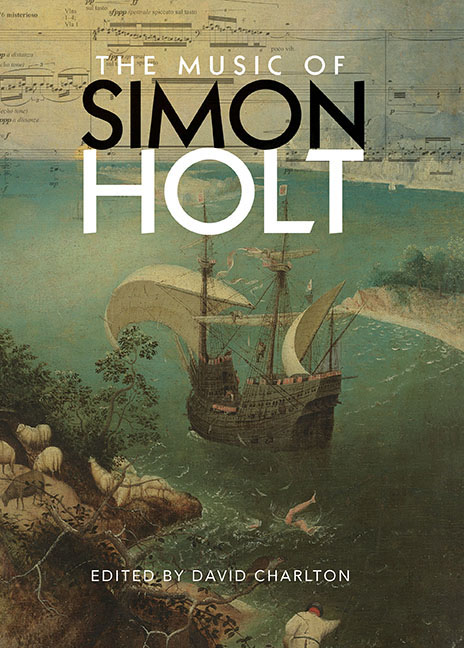Book contents
- Frontmatter
- Contents
- Figures and Tables
- Contributors
- Preface and Acknowledgements
- Abbreviations, with a note on recordings and scores
- Introduction Memories of Magical Moonlight: Simon Holt's years as a composition student
- 1 Duende y Duelos: The Andalusian spirit in the Lorca settings
- 2 An Interplay of Passion and Spirit: The Nightingale's to Blame
- 3 Images in Sound: Movement, harmony and colour in the early music
- 4 Myth and Narrative in 3 for Icarus
- 5 Sound, Sense and Syntax: The Emily Dickinson settings
- 6 Piano Music
- 7 Redefining the Cello's Voice: Musical agency in feet of clay
- 8 Performance and Reflections: Holt's music for oboe and cor anglais
- 9 Shaking the Bars: The Yellow Wallpaper
- 10 Listening to the River's Roar: Stance, texture and space in the concertos
- 11 Orchestral Works in Performance
- 12 Oblique Themes and Still Centres: A conversation between
- 13 Sketching and Idea-Gathering
- 14 Art, Conceptualism and Politics in Holt's music
- Appendix A Overview and Catalogue of Pieces
- Appendix B Texts by Simon Holt for Raju Raghuvanshi is a ghost and The Legend of Melusine
- Bibliography
- Index of pieces by Simon Holt
- General index
4 - Myth and Narrative in 3 for Icarus
Published online by Cambridge University Press: 01 September 2018
- Frontmatter
- Contents
- Figures and Tables
- Contributors
- Preface and Acknowledgements
- Abbreviations, with a note on recordings and scores
- Introduction Memories of Magical Moonlight: Simon Holt's years as a composition student
- 1 Duende y Duelos: The Andalusian spirit in the Lorca settings
- 2 An Interplay of Passion and Spirit: The Nightingale's to Blame
- 3 Images in Sound: Movement, harmony and colour in the early music
- 4 Myth and Narrative in 3 for Icarus
- 5 Sound, Sense and Syntax: The Emily Dickinson settings
- 6 Piano Music
- 7 Redefining the Cello's Voice: Musical agency in feet of clay
- 8 Performance and Reflections: Holt's music for oboe and cor anglais
- 9 Shaking the Bars: The Yellow Wallpaper
- 10 Listening to the River's Roar: Stance, texture and space in the concertos
- 11 Orchestral Works in Performance
- 12 Oblique Themes and Still Centres: A conversation between
- 13 Sketching and Idea-Gathering
- 14 Art, Conceptualism and Politics in Holt's music
- Appendix A Overview and Catalogue of Pieces
- Appendix B Texts by Simon Holt for Raju Raghuvanshi is a ghost and The Legend of Melusine
- Bibliography
- Index of pieces by Simon Holt
- General index
Summary
THE PAINTING Landscape with the Fall of Icarus (Figure 4.1, p. 84), attributed to Pieter Bruegel the elder, has inspired numerous ekphrastic responses, including poems by William Carlos Williams and Michael Hamburger and, musically, Brian Ferneyhough's La Chute d'Icare (1988). W. H. Auden's account of the painting in his poem Musée des Beaux Arts (1938) provided both stimulus and titles for Simon Holt's everything turns away for piano quintet (2010) and expensive delicate ship (the fourth movement of 3rd Quartet, 2013). But Holt's most sustained engagement with the Icarus myth and the art it has inspired can be found in his earlier trilogy 3 for Icarus: Icarus Lamentations for chamber ensemble (1992), Minotaur Games for orchestra (1993, rev. 2008) and Dædalus Remembers for solo cello and chamber ensemble (1995, rev. 1997). Though the titles of these three works might appear to signal a return to mythic origins, Holt's response to the Icarus legend was nevertheless mediated significantly by Landscape with the Fall of Icarus. In the way that the individual works respond to extramusical stimuli, along with the compelling, fantastically detailed and concentrated designs that emerge through this musical engagement, the trilogy surely ranks among Holt's most significant achievements.
In common with Holt's many titles inspired by the other arts, those given to the individual pieces comprising 3 for Icarus ‘only partially illuminate the truth of the music’. In this context, Holt's brief programme notes for the component pieces in 3 for Icarus are revealing. For the first, his account of the Icarus tale is prefaced by the comment that ‘[t]he shape of the piece doesn't necessarily follow the exact line of the myth but attempts to shed light in an almost cinematic way on various aspects of the story using a kind of “jump cut” technique’. For the second and third, there is even less apparent connection between mythical plot and musical design: Holt's programme notes pithily summarise the legends to which the titles refer, with no mention of the actual music. Titles and programme notes alike thus serve not as explanations, but as opening gambits in a narrative act in which composer and listener are complicit.
- Type
- Chapter
- Information
- The Music of Simon Holt , pp. 80 - 103Publisher: Boydell & BrewerPrint publication year: 2017

